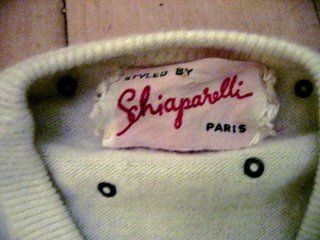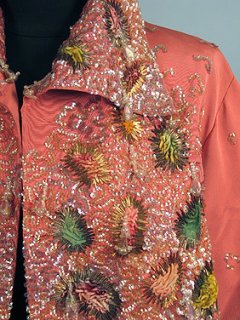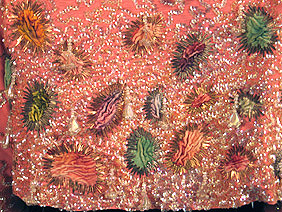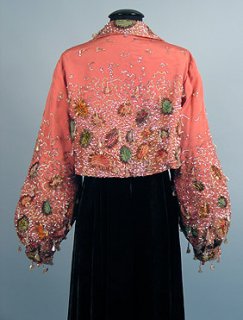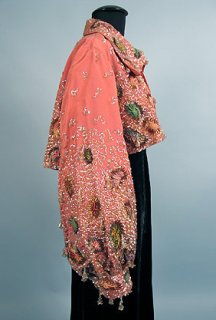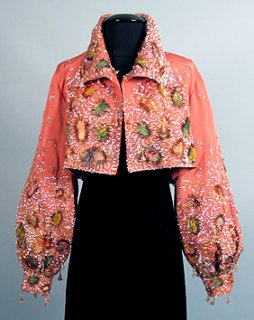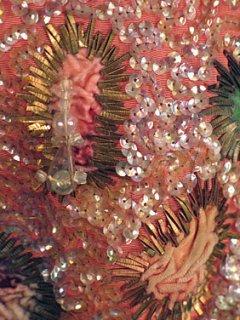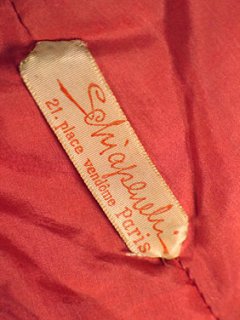part 2..
Schiaparelli was tiny—barely five feet tall—and her clothes looked best on petite, slender, dark-haired women like herself. Dilys Blum, curator of the splendid retrospective of Schiaparelli at the Philadelphia Museum of Art, says the female characters dressed by Schiaparelli in plays and movies were often divorcees, “man-eaters,” and women expressing a newfound independence: “women who knew what they wanted and went after it.” And they were more likely to have transformed themselves into women of style than to have been born beauties. In addition to the moles on her cheek, Schiaparelli had a long, strong-featured face, with heavy-lidded eyes. She believed herself to be plain, if not ugly. Like her, the private clients who exemplified her “hard chic” look were often jolies laides. If they turned heads at the Ritz or people stood on chairs to see them at Longchamps, it was because they had willed it. Through diet, discipline, and attention to self-presentation, the lady mastered fate.
Elsa Luisa Maria Schiaparelli was born in Rome in 1890, into a world of enormous privilege that she ran from because it suffocated her. Even being christened Elsa, she was to say, was a disappointment that represented “the beginning of her struggle.” Later she invited her friends—even Marisa and her sister, Berinthia, when they were tiny—to call her by the androgynous “Schiap” (pronounced Skap). She was a late child of her parents—a mother from a family of extroverted, adventurous, and superstitious Neapolitan nobility, and a father from a line of distinguished Piedmontese scholars and intellectuals. (Schiap herself was described as the most intelligent woman who ever designed clothes.) She was born in the Palazzo Corsini, a grand Renaissance pile that had sheltered Erasmus, Michelangelo, and Queen Christina of Sweden at various times.
Her father, Celestino, was the director of the Lincei Library and a friend of King Victor Emmanuel, with whom he shared a passion for numismatics. He was a formidable scholar who translated from ancient Arabic, Persian, and Sanskrit texts. He took his young daughter on a trip to Tunisia once. Years later, as a successful, thoroughly modern female entrepreneur, she would buy a house there, in Hammamet. Her uncle Giovanni was a world-renowned astronomer who created a furor by discovering on the surface of Mars the canali, or channels, that were thought to be proof of intelligent life. He was kindly enough to tell his small, thin, odd-looking little niece that her Great Bear birthmarks would bring her good luck. She reproduced the constellation on the chairs in her salon, on embroideries and prints, and on a diamond brooch she often wore.
Her mother, aunt, and much older sister were all considered great beauties, and her mother pointedly told Elsa that she was not. She sensed that her parents' world was rigid and repressed. (Her father didn't want her mother to attend court functions, because ladies there wore low-necked gowns.) Schiap was, Marisa says, “a rebellious spirit.” She wrote and published a book of poetry, of which her father disapproved. A CBS reporter once asked her where she had got the energy to do all she had done. “Goat's milk!” she shot back. (“She never drank goat's milk in her life!” Marisa says with a laugh.) Schiap left stuffy, provincial old Rome like a self-ignited rocket, going briefly to Paris and then to London. While there she attended a lecture on Theosophy, delivered in French by Count Wilhelm Wendt de Kerlor. He was a young man with good looks, great appeal to women, a long lineage in the Breton and Polish aristocracy, and psychic gifts (he foresaw the sinking of the Titanic), but no money. No sooner had he met Schiap than they became engaged. Her elderly parents rushed across Europe to prevent the wedding, but they were too late. When she and her new husband came back from the registry office, Schiap said, no fewer than seven mirrors in the house had cracked.
It was 1914, and all the youths of London except the bridegroom were in army uniform. The young count and countess, living on her small dowry, fled first to Nice and then, in 1916, to New York. On the crossing they met Gabrielle, the wife of the Dadaist artist Francis Picabia, but even without the Picabias' introductions they would probably have found themselves in the artistic community of Greenwich Village, a hotbed of radical ideas. They lived in the Brevoort Hotel and fell in with the circle around Marcel Duchamp and Alfred Stieglitz, through whom they met photographers like de Meyer, Steichen, and Man Ray. Unfortunately it seemed that the Village ethos of free love turned the head of the handsome Theosophist. It may have been his affair with Isadora Duncan that proved the last straw. The couple were already separated when Schiap gave birth to her only child—a daughter christened Maria Luisa Yvonne Radha but always known as Gogo. In later life Schiap never spoke about the wayward count. “That was a taboo subject with us,” says Marisa, who grew up seeing a lot of her grandmother and shared her town house in the rue de Berri in the last years of her life. “She had tremendous dignity and didn't like to share her emotions. She never talked about personal things or her private life. There was a lot that people didn't know, even those closest to her. I don't even think my mother had intimate conversations with her.” Her biographer, Palmer White, said that Schiap's self-mastery was so complete that she never smiled except when she had “time, commercial need, or in the company of her daughter and granddaughters.”
When Schiap found herself in a foreign land, nearly penniless, she pulled herself together, took a tiny flat in Patchin Place, and found odd jobs to support herself and her child. She sent her baby away to be taken care of in the countryside. When, in Shocking Life, she wrote as much as she wished to be known about her life, she put her more daring revelations in the third person. “Sorrow and loss [Schiap] readily accepts,” she wrote. “But she does not know how to deal with happiness. . . . If she is charming, she can also be the most hateful person in the world.” If she viewed herself with such detachment, it is perhaps not surprising that Gogo (whom she adored) would be kept at arm's length. When, after going to Cuba as companion to a wealthy but untalented Polish soprano, she returned to New York, she found that little Gogo wasn't walking properly. It turned out she had infantile paralysis. Ahead for the child would be many years of casts, crutches, expensive and painful treatments, and lengthy separations from her mother. “My mother didn't have an easy childhood,” Marisa says. In 1922 Schiap leaped at a chance to go to Paris and make a fresh start there. “Poverty forced me to work,” she said. “Paris gave me a liking for it, and courage.” Paul Poiret took a shine to her and gave her clothes to wear at the Ritz or the artists' hangout le Boeuf sur le Toit. Her life in America—which lasted longer than she later admitted because she had lopped six years off her official age—gave her an easy rapport with the expatriate Americans who dominated Parisian social life before the stock-market crash of 1929. Schiaparelli's genius—a deep-rooted European sensibility and cultural reference, combined with a zest for America's active lifestyle and love of novelty and speed—was exactly right for her times. She loved to be in motion herself. (CBS asked her how much of each year she spent at home in the rue de Berri. “Quite enough,” she said.) Whenever the modern world expressed itself, in the construction of the Empire State Building, the launch of Pan Am's first transatlantic clippers or of the liner the S.S. Normandie, the event inspired her collections. “If you define fashion as time moving (and that is what it is),” she wrote, “then you are not fully alive unless you are moving with it.” When the women aviators Amy Johnson and Amelia Earhart made their pioneering solo flights, they flew as Schiaparelli ladies from head to toe, even to their hats and evening gowns. Johnson stepped out of her plane in a special divided skirt and a blouse made from a fabric printed with a design of Schiaparelli's own press clippings.


![main_pict[1].jpg](https://thefashionspot-data.community.forum/attachments/529/529809-6c8bfa3e20b226909c39e667e038d650.jpg?hash=bIv6PiCyJp)















